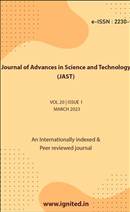Wastewater Treatment Using Constructed Wetland
DOI:
https://doi.org/10.29070/fjzapc98Keywords:
wastewater treatment, constructed wetland, pollutants, microbiology, contaminants, removal mechanisms, degradation routes, difficulties, applications, theoryAbstract
Municipal wastewater, wastewater from petroleum refineries, agricultural drainage, acid minedrainage, etc. have all benefited from the use of constructed wetlands (CW), an ecologically benignmethod for purging pollutants from wastewater. The science of microbiology has expanded at anastounding rate during the last decade. Focusing on developments in the previous three decades, thispaper provides a comprehensive assessment of important facets of CW, including its many forms, thecontaminants their removal mechanisms, degradation routes, difficulties, possibilities, materials,applications, and theory. Key unresolved issues in CW have also been framed in an effort to both foreseeand enable future progress in the area of CW. The rapidly expanding CW sector will benefit from theseguidelines, which have been created via the standardization of essential design components. In anattempt to standardize the rapidly expanding CW community, this study summarizes the present state ofthe art of CW technology assessment and offers definitions performance metric terminology.Downloads
References
Allen, G.H. and R.H. Gearheart (eds). 2021. Proceedings of a Conference on Wetlands for Wastewater Treatment and Resource Enhancement. Humbolt Sate Univ., Arcata, CA
Brinson, M.M. and F.R. Westall. 2018. Application of Wastewater to Wetlands. Rept. #5, Water Research Inst., Univ. of North Carolina, Raleigh, NC
Brix, H. 2019. Treatment of Wastewater in the Rhizosphere of Wetland PlantsùThe Root Zone Method. Water Sci Technol., 19:107-118
Brown, M.T. 2020. Evaluating Constructed Wetlands Through Comparisons with Natural Wetlands. EPA/6003-91-058. EPA Environmental Research Lab., Corvallis.
Chan, E., T.A. Bunsztynsky, N. Hantzsche, and Y.J. Litwin. 1981. The Use of Wetlands for Water Pollution Control. EPA-600/S2-82-086. EPA Municipal Environmental Research Lab., Cincinnati.
Confer, S.R. and W.A. Niering. 2021. Comparison of Created and Natural Freshwater Emergent Wetlands in Connecticut (USA). Wetlands Ecology & Management. 2(3):143-156
Cooper, P.F. and B.C. Findlater. 2020. Constructed Wetlands in Water Pollution Control. IAWPRC. Pergamon Press, Inc., Maxwell House.
Etnier, C. and B. Guterstam. 2019. Ecological Engineering for Wastewater Treatment. Bokskogen, Gothenburg, Sweden
Gamroth, M.J. and J.A. Moore. April 2018. Design and Construction of Demonstration/Research Wetlands for Treatment of Dairy Farm Wastewater. EPA/600/R-93/105. EPA Environmental Research Laboratory, Corvallis.
Gersberg, R.M., S.R. Lyon, B.Y. Elkins, and C.R. Goldman. 2016. The Removal of Heavy Metals by Artificial Wetlands. EPA-600/D-84-258. Robt. S. Kerr Env. Research Lab., Ada, OK
Gersberg, R.M., B.V. Elkins, S.R. Lyon and C.R. Goldman. 2014. Role of Aquatic Plants in Wastewater Treatment by Artificial Wetlands. Water Res. 20:363-368
Good, R.E., D.F. Whigham, and R.L. Simpson (eds). 2019. Freshwater Wetlands: Ecological Processes and Management Potential. Academic Press, New York, NY
Greeson, P.E., J.R. Clark & J.E. Clark (eds). 2014. Wetland Functions and Values: The State of Our Understanding. Amer. Water Resources Assoc., Minneapolis, MN
Hammer, D.A. (ed). 2019. Constructed Wetlands for Wastewater Treatment - Municipal, Industrial & Agricultural. Lewis Publ., Chelsea, MI
Hammer, D.E. and R.H. Kadlec. 2020. Design Principles for Wetland Treatment Systems. EPA600/S2-83-026. EPA Municipal Environmental Research Lab, Cincinnati, OH
Hook, D.D. et. al. 2017. The Ecology and Management of Wetlands (2 vols.). Croom Held, Ltd., London/Timber Press, Portland, OR
Hyde, H.C. R.S. Ross and F.C. Demgen. 2017. Technology Assessment of Wetlands for Municipal Wastewater Treatment. EPA 600/2-84-154. EPA Municipal Environmental Research Lab., Cincinnati, OH
Kusler, J.A. and M.E. Kentula (eds). 2021. Wetland Creation and Restoration: The Status of the Science. Island Press, Washington, DC
Nixon, S.W. and V. Lee. 2018. Wetlands and Water Quality: A Regional Review of Recent Research in the U.S. on the Role of Freshwater and Saltwater Wetlands as Sources, Sinks, and Transformers of Nitrogen, Phosphorus, and Heavy Metals. Technical Rept. Y-86-2, U.S. Army Corps of Engineers Waterways Experiment Station, Vicksburg, MS
Reed, S.C., R. Bastian, S. Black, and R. Khettry. 2016. Wetlands for Wastewater Treatment in Cold Climates. IN: Future of Water Reuse, Proceedings of the Water Reuse Symposium III. Vol. 2:962-972. AWWA Research Foundation, Denver, CO
Richardson, C.J. 2018. Mechanisms Controlling Phosphorous Retention Capacity in Freshwater Wetlands. Science 228:1424-1427
Stockdale, E.C. 2017. Freshwater Wetlands, Urban Stormwater, and Nonpoint Pollution Control: A Literature Review and Annotated Bibliography. 2nd Ed. WA Dept. of Ecology, Olympia, WA
Strecker, E.W., J.M. Kersnar, E.D. Driscoll & R.R. Horner. April 2014. The Use of Wetlands for Controlling Stormwater Pollution. The Terrene Inst., Washington, DC
Tourbier, J. and R.W. Pierson (eds). 2019. Biological Control of Water Pollution. Univ. of Pennsylvania Press, Philadelphia, PA






